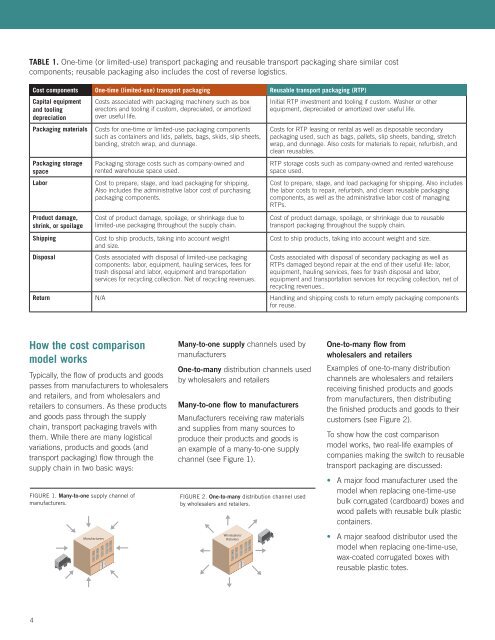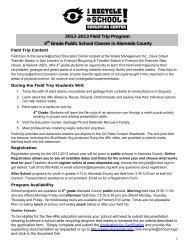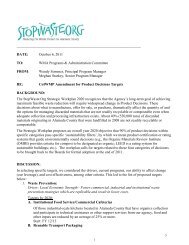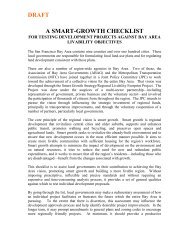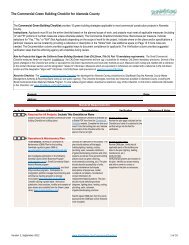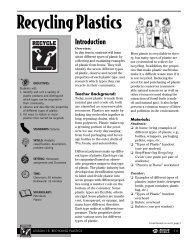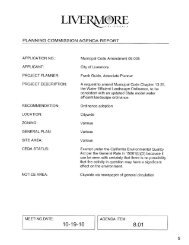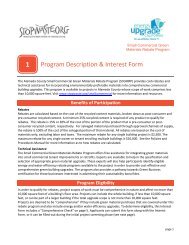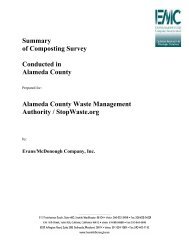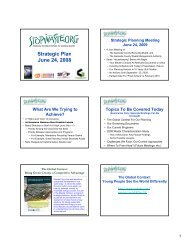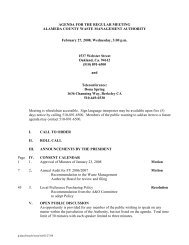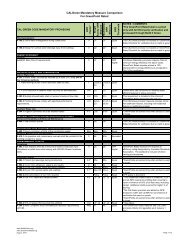Reusable Transport Packaging - StopWaste.org
Reusable Transport Packaging - StopWaste.org
Reusable Transport Packaging - StopWaste.org
You also want an ePaper? Increase the reach of your titles
YUMPU automatically turns print PDFs into web optimized ePapers that Google loves.
Table 1. One-time (or limited-use) transport packaging and reusable transport packaging share similar cost<br />
components; reusable packaging also includes the cost of reverse logistics.<br />
Cost components One-time (limited-use) transport packaging <strong>Reusable</strong> transport packaging (RTP)<br />
Capital equipment<br />
and tooling<br />
depreciation<br />
<strong>Packaging</strong> materials<br />
<strong>Packaging</strong> storage<br />
space<br />
Labor<br />
Costs associated with packaging machinery such as box<br />
erectors and tooling if custom, depreciated, or amortized<br />
over useful life.<br />
Costs for one-time or limited-use packaging components<br />
such as containers and lids, pallets, bags, skids, slip sheets,<br />
banding, stretch wrap, and dunnage.<br />
<strong>Packaging</strong> storage costs such as company-owned and<br />
rented warehouse space used.<br />
Cost to prepare, stage, and load packaging for shipping.<br />
Also includes the administrative labor cost of purchasing<br />
packaging components.<br />
Initial RTP investment and tooling if custom. Washer or other<br />
equipment, depreciated or amortized over useful life.<br />
Costs for RTP leasing or rental as well as disposable secondary<br />
packaging used, such as bags, pallets, slip sheets, banding, stretch<br />
wrap, and dunnage. Also costs for materials to repair, refurbish, and<br />
clean reusables.<br />
RTP storage costs such as company-owned and rented warehouse<br />
space used.<br />
Cost to prepare, stage, and load packaging for shipping. Also includes<br />
the labor costs to repair, refurbish, and clean reusable packaging<br />
components, as well as the administrative labor cost of managing<br />
RTPs.<br />
Product damage,<br />
shrink, or spoilage<br />
Cost of product damage, spoilage, or shrinkage due to<br />
limited-use packaging throughout the supply chain.<br />
Cost of product damage, spoilage, or shrinkage due to reusable<br />
transport packaging throughout the supply chain.<br />
Shipping<br />
Disposal<br />
Cost to ship products, taking into account weight<br />
and size.<br />
Costs associated with disposal of limited-use packaging<br />
components: labor, equipment, hauling services, fees for<br />
trash disposal and labor, equipment and transportation<br />
services for recycling collection. Net of recycling revenues.<br />
Cost to ship products, taking into account weight and size.<br />
Costs associated with disposal of secondary packaging as well as<br />
RTPs damaged beyond repair at the end of their useful life: labor,<br />
equipment, hauling services, fees for trash disposal and labor,<br />
equipment and transportation services for recycling collection, net of<br />
recycling revenues..<br />
Return N/A Handling and shipping costs to return empty packaging components<br />
for reuse.<br />
How the cost comparison<br />
model works<br />
Typically, the flow of products and goods<br />
passes from manufacturers to wholesalers<br />
and retailers, and from wholesalers and<br />
retailers to consumers. As these products<br />
and goods pass through the supply<br />
chain, transport packaging travels with<br />
them. While there are many logistical<br />
variations, products and goods (and<br />
transport packaging) flow through the<br />
supply chain in two basic ways:<br />
Figure 1. Many-to-one supply channel of<br />
manufacturers.<br />
Manufacturers<br />
Many-to-one supply channels used by<br />
manufacturers<br />
One-to-many distribution channels used<br />
by wholesalers and retailers<br />
Many-to-one flow to manufacturers<br />
Manufacturers receiving raw materials<br />
and supplies from many sources to<br />
produce their products and goods is<br />
an example of a many-to-one supply<br />
channel (see Figure 1).<br />
Figure 2. One-to-many distribution channel used<br />
by wholesalers and retailers.<br />
Wholesalers/<br />
Retailers<br />
One-to-many flow from<br />
wholesalers and retailers<br />
Examples of one-to-many distribution<br />
channels are wholesalers and retailers<br />
receiving finished products and goods<br />
from manufacturers, then distributing<br />
the finished products and goods to their<br />
customers (see Figure 2).<br />
To show how the cost comparison<br />
model works, two real-life examples of<br />
companies making the switch to reusable<br />
transport packaging are discussed:<br />
• A major food manufacturer used the<br />
model when replacing one-time-use<br />
bulk corrugated (cardboard) boxes and<br />
wood pallets with reusable bulk plastic<br />
containers.<br />
• A major seafood distributor used the<br />
model when replacing one-time-use,<br />
wax-coated corrugated boxes with<br />
reusable plastic totes.


